AMD Ryzen 9 5980HS Cezanne Review: Ryzen 5000 Mobile Tested
by Dr. Ian Cutress on January 26, 2021 9:00 AM EST- Posted in
- CPUs
- AMD
- Vega
- Ryzen
- Zen 3
- Renoir
- Notebook
- Ryzen 9 5980HS
- Ryzen 5000 Mobile
- Cezanne
Ryzen 5000 Mobile: SoC Upgrades
While the introduction page focuses mainly on the change to Zen 3 cores, AMD has explained to AnandTech that there are plenty of other changes in this update which enable both performance and efficiency, as well as battery life enhancements, for users.
From this point on I will start using the silicon codenames, such as
- Cezanne (Ryzen 5000 Mobile with Zen 3),
- Lucienne (Ryzen 5000 Mobile with Zen 2),
- Renoir (Ryzen 4000 Mobile, all Zen 2),
- Vermeer (Ryzen 5000 Desktop, all Zen 3),
- Matisse (Ryzen 3000 Desktop, all Zen 2)
Double Cache and Unified Cache for Cezanne
To reiterate the primary SoC change for Cezanne compared to Renoir, the eight cores now have a unified cache rather than two cache segments. On top of this, the cache size has also doubled.
This is similar to what we saw on the desktop, when AMD introduced Vermeer – Vermeer with Zen 3 had a unified cache over Matisse with Zen 2. At that time, AMD was pointing to the unified cache enabling better gaming performance as it lowered the ‘effective’ latency for CPU memory requests in that combined cache region. The same thing is expected to hold true for the new Cezanne silicon in Ryzen 5000 Mobile, and will play a key part in enabling that +19% IPC increase from generation to generation.
Improved Memory Controller for Cezanne and Lucienne
One of the key metrics in mobile processors is the ability to eliminate excess power overhead, especially when transitioning from an active state to an idle state. All major silicon vendors that build laptop processors work towards enabling super-low power states for when users are idle, because it increases battery life.
A lot of users will be used to features that keep the processor cores in low power states, or the graphics, but also part of this is the interconnect fabric and the memory controller. One of the new developments for Ryzen 5000, and in both Cezanne on Zen 3 and Lucienne on Zen 2, is that AMD has enabled deeper low-power states for the memory physical layer (PHY) interface. This enables the system to save power when the memory subsystem is either not needed or in a period of low activity. This means putting the fabric and memory on its own voltage plane, but also enabling the required logic to drive it to a lower power when idle. AMD states that the low-dropout regulators (LDOs) are configured to enable this transition, and in certain circumstances, allow the PHY to be bypassed to further lower power consumption.
The tradeoff with having a part of the processor in such a low power state is the time it takes to recover from idle, which is also a metric to keep track of. AMD is stating that the design in Ryzen 5000 also enables a fast exit to full activity, meaning that the high performance modes can be entered quickly.
Also on the memory front, it would appear that AMD is doubling capacity support for both LPDDR4X and DDR4. For this generation, Cezanne systems can be enabled with up to 32 GB of LPDDR4X-4267 (68.2 GB/s), or up to 64 GB of DDR4-3200 (51.2 GB/s). The benefits of LPDDR4X are lower power and higher bandwidth, while DDR4 enables higher capacity and a potentially upgradable design.
Per-Core Voltage Control for Cezanne and Lucienne
In line with the same theme of saving power, not only should the periphery of the core be managed for idle use, but the cores should as well. In Ryzen 4000 Mobile, AMD had a system whereby each core could have a separate frequency, which saved some power, but the drawback was that all the cores were on a single voltage plane and so even if a core was idle when another one was heavily loaded, all cores were running at that top voltage. This changes with all members of the Ryzen 5000 Mobile family, as both Cezanne and Lucienne will both feature voltage control on a per-core level.
The slide from AMD shows it best – the cores running at higher frequencies get higher voltage, and the cores that are idling can reduce their voltage to save power. One of the main limits to enabling this sort of profile, aside from actually having the control to do it in the first place, is to do it fast enough for it both to count towards power consumption but also such that it is transparent to the user – the cores should still be able to come to a high voltage/high frequency state within a suitable time. AMD’s design works with operating system triggers and quality of service hooks to apply high-frequency modes in a task-based format.
On AMD’s desktop processors, we saw that the introduction of a feature called CPPC2 helped enable this, and the same is true on the mobile processors, however it took another generation to do the required design and firmware changes.
Power and Response Optimization (CPPC2) for Cezanne and Lucienne
As we accelerate into the future of computing, making the most out of each individual bit of silicon is going to matter more. This means more control, more optimization, and more specialization. For Cezanne and Lucienne, AMD is implementing several CPPC2 features first exhibited on desktop silicon to try and get the most out of the silicon design.
‘Preferred Core’ is a term used mostly on the desktop space to indicate which CPU core in the design can turbo to the highest frequency at the best power, and through a series of operating system hooks, the system will selectively run all single-threaded workloads on that core assuming no other workload is present. Previously, threads could bounce around to enable a more equal thermal distribution – AMD will now selectively keep the workload on the single core until thermal limits kick in, enabling peak performance and no extra delays from thread switching. For overclockable systems, this typically also represents the best core for boosting the frequency, which becomes relevant for Ryzen 5000 Mobile and the new HX series processors.
Another part of CPPC2 is frequency selection, which reduces the time for the transition from low-frequency to high-frequency from 30 milliseconds down to under 2 milliseconds. This equates to a 2-frame adjustment in frequency being reduced down to sub-frame adjustments. The consequences of this enables workloads that occur for shorter than 30 milliseconds can take advantage of a momentarily higher frequency and get completed quicker – it also enables the system to be more responsive to the user, not only in idle-to-immediate environments, but also in situations where power is being distributed across the SoC and those ratios are adjusting for the best performance, such as when the user is gaming. Also enabling load-to-idle transitions on the order of 2 milliseconds improves battery life by putting the processor in a lower power state both quicker and more often, such as between key presses on the keyboard.
The third part of CPPC2 is the migration away from discrete legacy power states within the operating system. With an OS that has a suitable driver (modern Windows 10 and Linux), frequency control of the processor is returned back from the OS to the processor, allowing for finer grained transitions of when performance or power saving is needed. This means that rather than deal with the several power states we used to, the processor has the full continuous spectrum of frequencies and voltages to enable, and will analyze the workflow to decide how that power is distributed (the operating system can give hints to the processor to aid in those algorithms).
GPU Improvements on Cezanne and Lucienne: Vega 8 to Vega 8+
As mentioned on the previous page, one of the criticisms leveled at this new generation of processors is that we again get Vega 8 integrated graphics, rather than something RDNA based. The main reason for this is AMD’s re-use of design in order to enable a faster time-to-market with Zen 3. The previous generation Renoir design with Zen 2 and Vega 8 was built in conjunction with Cezanne to the point that the first samples of Cezanne were back from the fab only two months after Renoir was launched.
If we look at the change in integrated graphics from the start of Ryzen Mobile. The first generation Raven Ridge was built on 14nm, had Vega11 graphics, and had a maximum frequency around 1200 MHz. The graphics in that Renoir design were built on 7nm, and despite the jump down from Vega11 to Vega8, efficiency was greatly increased and frequency had a heathy already a jump up to 1750 MHz. Another generation on to Cezanne and Lucienne, and the graphics gets another efficiency boost, enabling +350 MHz for added performance.
Part of this update is down to tweaks and minor process updates. AMD is able to control the voltage regulation better to allow for new minimums, reducing power, and has enabled a new frequency sensitive prediction model for performance. With the greater power controls on the CPU and SoC side, this means that power budget can be more readily accessible by the integrated graphics, allowing for higher peak power consumption, which also helps boost frequency.
Note that these features apply to both Cezanne and Lucienne, meaning that the Zen 2 products in the Ryzen 5000 Mobile do get a sizeable boost in graphics performance over Renoir here. Ultimately it is that 15 W market for which this update is aimed, given that the H-series (including HS and HX) are likely to be paired with discrete graphics cards.
As and when AMD decides to move from Vega to RDNA, we’re likely going to see some of the Cezanne be re-used such that we might see Zen3 + RDNA in the future, or the combined Zen 4 + GPU chip might be a full upgrade across the board. This is all speculation, but AMD’s CEO Lisa Su has stated that being able to re-use silicon designs like this is a key part of the company’s mobile processor philosophy going forward.
Security Updates in Cezanne
One of the features of Zen 3 is that it enables AMD’s latest generation of security updates. The big update in Zen 3 was the additional of Control Flow Enforcement Technology, known as CET. This is where the processor will create shadow stacks for return calls to ensure that the correct return addresses are called at the end of functions; similarly indirect branch jumps and calls are monitored and protected against should an attacker attempt to modify where an indirect branch is headed.
Both AMD and Intel have spoken about including Microsoft Pluton security in their processors, and we can confirm that neither Cezanne nor Lucienne have Pluton as part of the design. Both AMD and Intel have stated that it will be integrated ‘in the future’, which seems to suggest we may still be another generation or two away.
Process Node Updates on Cezanne and Lucienne
Perhaps one of the smaller updates this time around, but AMD has stated that both Cezanne and Lucienne use the latest intra-process node updates on N7 for these products. While both previous generation Renoir and these two use TSMC’s N7 process, over the lifecycle of the manufacturing node minor changes are made, sometimes to reduce defect density/increase yield, while others might be voltage/frequency updates enabling better efficiency or a skew towards better binning at a different frequency. Usually these additions are minor to the point of not being that noticeable, and AMD hasn’t said much beyond ‘latest enhancements’.


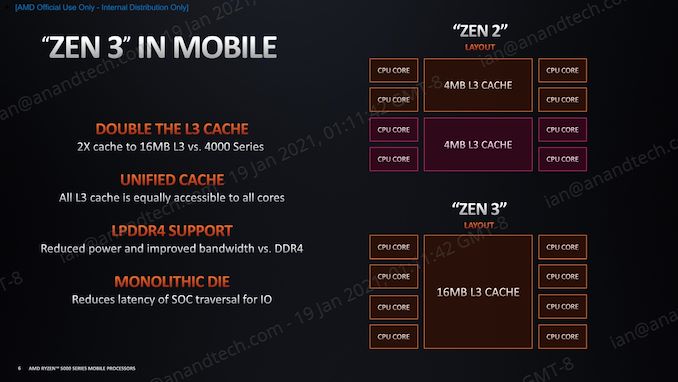
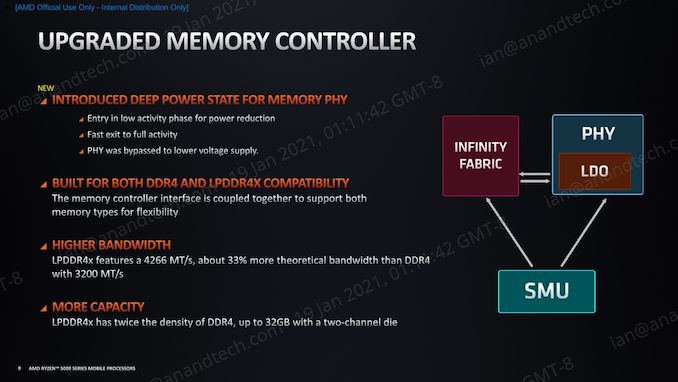

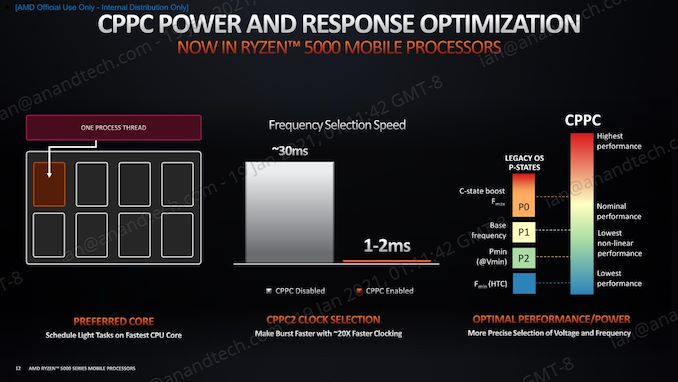
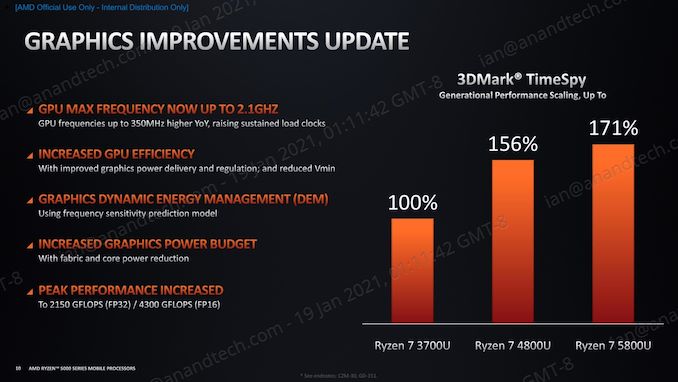
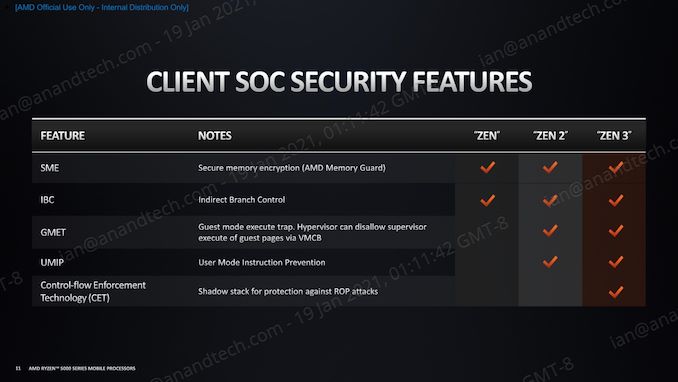








218 Comments
View All Comments
Meteor2 - Thursday, February 4, 2021 - link
Web JavaScript benchmarks really don't count for much. They certainly don't reflect the user experience of the web.DigitalFreak - Tuesday, January 26, 2021 - link
It's all about the money, and I'm pretty sure Intel is handing out more marketing funds and rebates than AMD. Most people don't care if they have Intel or AMD in their laptop.msroadkill612 - Tuesday, January 26, 2021 - link
Yes its about money and no Intels strategies dont seem to be hiding reality so well these days - OEMs are deserting their designs in droves.There is a deal breaking cost & power saving at the mainstream mobile sweet spot, where the APU delivers competent modern graphics w/o need of a DGPU.
Intel can only match amd graphics by adding a dgpu.
Deicidium369 - Wednesday, January 27, 2021 - link
"OEMs are deserting their designs in droves." Really? So now only 10:1 vs AMD designs?Deicidium369 - Wednesday, January 27, 2021 - link
Providing designs to OEMs and supplying most of the parts for a laptop - making it super easy for them to come to market with an Intel design... That's called smart business.Spunjji - Thursday, January 28, 2021 - link
That's not the same thing as marketing funds and rebates, which Intel also do - they even do it at the reseller level.So there's "smart business", then there's "buying marketshare", and then there's "outright bribery". Intel got fined for doing the last one, so now they mostly only do the first two - although it's a toss-up as to whether you think their contra-revenue scheme counted as option 2 or 3.
theqnology - Wednesday, January 27, 2021 - link
It's easy to compare them (M1 vs x86) on some metrics, but I think it is more nuanced than that. Do note that M1 is at 5nm, with size at around 120.5mm^2. The AMD parts are at 180mm^2 at 7nm. The M1 has 16 billion transistors versus 10.7 billion transistors for the Zen3 APUs. That is 49.5% more transistors in favor of M1.I think a huge part of the reason M1 performs so well in many benchmarks, are that it can target specific workloads, and offload it to specific hardware cores for specific accelerated performance at lower power consumption. It becomes easy for Apple to achieve such, I think, because this is all transparent from the application developers, as they control the entire hardware AND software stack, much like consoles performing at high-end GPU levels despite having less powerful GPU cores.
This is not a cost-effective approach, although not impossible for AMD and Intel. Also part of the reason why I think if M1 were put into cloud servers, it would not be cost-effective. There will be so much dedicated hardware accelerated cores that will not be put to use when M1 is deployed in the cloud.
That said, Apple M1 is a great feat. Hopefully, AMD can also achieve a similar feat (high efficiency accelerated processing) using their Infinity Fabric and glue, allowing them to continue focusing on their Zen cores while also uplifting ancillary workload performance. The big impediment here, would be the OS support, unless it becomes a standard.
GeoffreyA - Sunday, January 31, 2021 - link
An interesting thought and one I'd like to see reviewers looking into. Also, if it were possible to get Windows ARM running on the M1, that would be an insightful experiment, removing Apple's software layers out of the picture.Deicidium369 - Wednesday, January 27, 2021 - link
Intel is in premium laptops because they make it easy for the OEMs to make good designs - not only the "blueprints" but also high efficiency parts other than just the CPU. So an OEM has little to no R&D expense, and can roll out a great laptop.AMD should do the same - it's good business and would negate the reticence of the OEMs to invest in a smaller segment - not like this would have AMD selling more than Intel - but would improve their market presence in laptops significantly.
Spunjji - Thursday, January 28, 2021 - link
"AMD should do the same"I suspect they will once they have the funds to do so. You can't just bully your way into a market by copying the precise strategies of a company that's several times larger than you.